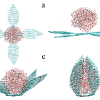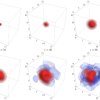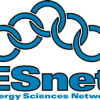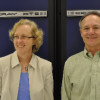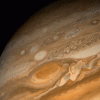News Archive
Bringing Clouds into Focus:
Clouds exert two competing effects on the Earth's temperature: they cool the planet by reflecting solar radiation back to space, but they also warm the planet by trapping heat near the surface. These two effects coexist in a delicate balance. Read More »
NERSC Users Find That Nanodroplets of Water Can Manipulate Graphene
Chemists from the University of Illinois at Chicago using the National Energy Research Scientific Computing Center's (NERSC) Cray XT4 supercomputer, called Franklin have found that nanodroplets of water can be used to shape graphene into complex capsules, sandwiches, knots, and rings to serve as the building blocks of nanodevices with unique mechanical, electrical, and optical properties. Read More »
Brace for Impact: Why Does Matter Dominate Our Universe?
While the fireworks at CERN's Large Hadron Collider (LHC) transfix the world, theorists are quietly doing some computational heavy lifting to help understand what these particle smash-ups might reveal about the fundamental mystery of existence: Why is there anything at all? Read More »
ESnet Reaches First Milestone in ANI Deployment with Infinera DWDM Installation
In March of this year, the U.S. Department of Energy's Energy Sciences Network (ESnet) completed the first milestone in constructing its Advanced Network Initiative (ANI) testbed by installing Infinera's dense wavelength-division multiplexing (DWDM) equipment. DWDM refers to optical networking systems that can send large volumes of data over multiple wavelengths of light on a single fiber. Read More »
Gregory Bell Joins ESnet as Chief Information Strategist
BERKELEY, CA. Gregory Bell has joined the U.S. Department of Energy's (DOE) Energy Sciences Network (ESnet) as chief information strategist. In this newly formed position, Bell will integrate emerging technologies into the ESnet infrastructure, work with team members to develop guidance on complex IT issues, and drive collaboration across the organization in support of a shared vision. Read More »
NERSC and JGI Join Forces to Tackle Genomics HPC
A torrent of data has been flowing from the advanced sequencing platforms at the Department of Energy Joint Genome Institute (JGI), among the world's leading generators of DNA sequence information for bioenergy and environmental applications. Last year, JGI generated over one trillion nucleotide letters of genetic code for its various user programs, an eight-fold increase in productivity from 2008. This year JGI expects to sequence five-times more data than the previous year, producing more than a petabyte of data. Read More »
Aydın Buluç, 2010 Alvarez Fellow
As the 2010 Luis W. Alvarez Fellow, Aydın Buluç will apply his expertise in combinational scientific computing primarily to increasing the reliability of the electrical grid and improve the nation's ability to respond to energy disruptions as a member of the Lawrence Berkeley National Laboratory's High Performance Computing Research Department (HPCRD). His research interests include parallel computing, combinatorial scientific computing, high performance graph analysis and sparse matrix computations. Read More »
Anubhav Jain, 2011 Alvarez Fellow
As a 2011 Luis W. Alvarez Fellow, Anubhav Jain will be working on the Materials Genome project, a large collaboration that uses quantum calculations to compute and catalog the properties of all inorganic compounds. Initially, the team will compute the properties of about 50,000 known compounds. Eventually, they hope to predict yet-unknown compounds. Read More »
Berkeley Lab Researchers Help Establish a Next Generation Data Analysis Center
Researchers in the Lawrence Berkeley National Laboratory's (Berkeley Lab) Computational Research Division (CRD) will receive approximately $1 million over the next four years to help establish a new, state-of-the-art visualization data and analysis center aimed at interpreting the massive amounts of data produced by today's most powerful supercomputers. Read More »
NERSC Helps Locate Jupiter's Missing Neon
It's raining helium on Jupiter—and as these droplets fall towards the planet's deeper interior, they are bringing neon down with them. Read More »







 Instagram
Instagram YouTube
YouTube
